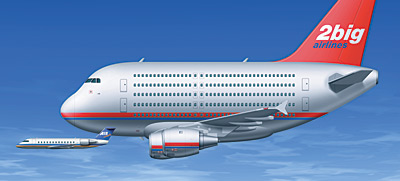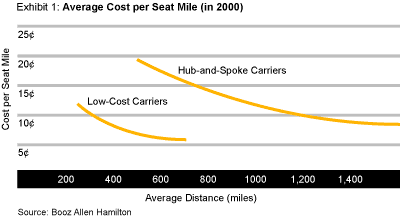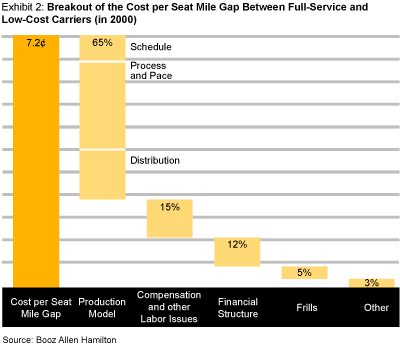Flight for Survival: A New Business Model for the Airline Industry
To pare down their colossal operating costs, giant U.S. and European carriers must restructure the hub-and-spoke system and eliminate complexity.
Since the 1970s, traditional market leaders in industry after industry, saddled with complex, high-cost business models, have been under attack by companies with new, simpler ways to manage their operations and contain costs.
 |
|
Illustration by Peter Kramer |
This scenario occurred in the steel industry when minimills took on traditional smelters; in automobile manufacturing when more standardized Japanese cars won out over customized U.S. vehicles; and in retailing when superstores overtook conventional grocery stores. In each instance, the established companies struggled, often in vain, to rationalize operations and still deliver products and services to satisfy customer desires, defend their market positions, and reestablish profitability.
The lesson is fundamental: As markets mature, incumbent companies that have developed sophisticated, but complex, business models face tremendous pressure to find less costly approaches that meet broad customer needs with minimal complexity in products and processes.
The trouble is, many companies — manufacturers and service providers alike — have increased the scope and variety of their products and services over the years by layering on new offerings to serve ever larger and more diverse customer bases. Although each individual business decision to enhance a product line or service can usually be justified on its own, the result often is a cost structure that is sustainable only if the principal competitors take a similar approach. More often than not, though, as incumbents expand the breadth and depth of their offerings, leveraging their sophisticated business infrastructure, they are undermined by smaller, nimbler competitors that supply a more focused product, usually to a specific set of customers, at a substantially lower cost. In these situations, the incumbent may know that the cost of complexity is dragging it down, but finds changing its business model easier said than done.
No companies illustrate this dilemma more vividly than the large U.S. and European hub-and-spoke airlines. Their business model — essentially designed to seamlessly take anyone from anywhere to everywhere — was a great innovation. But this model is no longer competitively sustainable in its current form. Tied to massive physical infrastructure, complex fleets of aircraft, legacy information systems, and large labor pools, the major carriers in both regions now face a double whammy: some of the worst economic conditions in the industry’s history, and low-cost carriers that dictate prices in large and growing parts of the market.
U.S. carriers lost more than $10 billion in 2002, according to the Air Transport Association, up from $8 billion in the disastrous year of 2001. Worldwide, losses topped $50 billion. Bankruptcies litter the industry. Sabena, Swissair, US Airways, United Air Lines, and Hawaiian Airlines have all sought protection from their creditors. Others are likely to follow. The need for a new, less complex business model among hub-and-spoke carriers is growing stronger with each boom and bust cycle.
In this article, we examine the significant downside of business complexity and provide a formula that would allow the airlines to simplify their operations, cut expenses, and compete with their low-cost competitors. It’s not incremental change, but a fundamental overhaul.
Complexity Costs
While the major carriers face a future of red ink, low-cost carriers such as Southwest Airlines, JetBlue Airways, and Ryanair are prospering by exploiting a huge cost-of-operations advantage. Low-cost carriers spend seven to eight cents per seat mile to complete a 500- to 600-mile flight, according to our analysis. That’s less than half of what it costs the typical hub-and-spoke carrier to fly a flight of the same duration and distance. (See Exhibit 1.)

It is easy to see how costs mount quickly in the hub-and-spoke airlines’ intricate system of operations. Their business model is predicated on offering consumers a larger number of destinations, significant flexibility (ranging from last-minute seat reassignments and upgrades to complete itinerary and routing changes), and “frills” (e.g., specialty meals, private lounges, and in-flight entertainment). It is a model burdened by the built-in cost penalties of synchronized hub operations, with long aircraft turnaround times and slack built into schedules to increase connectivity by ensuring there is time for passengers and baggage to make connections. It’s a system that implicitly accepts a slower business pace to accommodate continual change. In addition, the hub-and-spoke business model relies on highly sophisticated information systems and infrastructure to optimize its complex operations. By contrast, low-cost carriers have designed a focused, simple, highly productive business model around nonstop air travel to and from medium- to high-density markets at a significantly lower price point.
We have analyzed the cost gap between large full-service airlines and low-cost carriers (LCCs) on both sides of the Atlantic, and the similarities are striking. On both continents, cost differences exist across the board: pilots, onboard services, sales and reservations, maintenance, aircraft ownership, ground handling. The low-cost carriers are not simply paying lower salaries or using cheaper airports, they are leveraging all resources much more effectively. In fact, the cost differential between the full-service and low-cost carriers is 2 to 1 for the same stage length and aircraft, even after adjustments for differences in pay scales, fuel prices, and seat density are made.
Surprisingly, only about 5 percent of this cost differential can be attributed to the extra amenities the hub-and-spoke carriers offer. Some 65 percent of the LCCs’ cost advantage is the result of other production-model choices; another 15 percent comes from work rules and labor agreements; and 12 percent can be attributed to differences in balance-sheet structure and financial arrangements. (See Exhibit 2.)

Of the costs attributable to production-model differences, the largest contributing factors are business pace, process complexity, and ticket distribution. In fact, “no frills” and “full service” are misleading labels to describe the distinction between the two types of carriers. It is the relative simplicity or complexity of their operations that truly distinguishes them.
Most debilitating for the major carriers is the inability to overcome their cost burden with boom period pricing, as they did in the second half of the 1990s. As corporations tightened their belts and reduced the frequency of travel, business travelers, who have traditionally accounted for as much as 60 percent of mainline airline revenues — and well over 100 percent of their profits — were no longer willing to pay the high fares they tolerated in the dot-com boom. Weakened by this fundamental change in customer choice as well as “industry leading” labor agreements and rising fuel prices, the U.S. hub-and-spoke airlines’ cost per seat mile (CASM) rose above revenue per seat mile (RASM) by the third quarter 2000, a full year before the September 11 terrorist attack slashed air travel further. This eventually increased to an unprecedented cost-to-revenue gap of close to 2 cents per seat mile at the beginning of 2002 in the U.S.
That revenue outlook is likely to get worse. By our conservative estimates, low-cost carriers could potentially — and successfully — participate in more than 70 percent of the U.S. domestic market. Southwest Airlines typically prices 50 percent lower than large carriers in one- to two-hour nonstop markets. Even though traditional airlines have attracted a richer business mix than the low-cost carriers, they still stand to lose 25 to 35 percent price realization in those markets.
Recently, hub-and-spoke airlines have been trying to lower operating costs through new, less onerous labor agreements — American Airlines, United Air Lines, and US Airways have led the way in eking out pay concessions from their employees; negotiating better deals with intermediaries and financiers; eliminating discretionary costs; and, in some cases, smoothing out hub operations. Major carriers in the U.S. and Europe have also announced that they will add low-cost airline subsidiaries to their business portfolios to compete with the likes of Ryanair and Southwest Airlines.
A New Path
Many of these restructuring initiatives are clearly valuable and necessary, but they will likely not prove to be enough. Core airline operations need to become competitive with those of low-cost carriers, especially as LCC market penetration grows in the U.S. and makes inroads in Europe. The steps large carriers have taken so far do not address the fundamental productivity differences between themselves and the low-cost airlines. Traditional airlines will not achieve a competitive cost structure if they do not tackle the fundamental cost penalties associated with their business models. But they must do so without compromising the services, service quality, and coverage that distinguish them from their new rivals.
Although making such fundamental changes in a long-standing business model is difficult and risky, it is not without precedent. Successful change in other industries — such as manufacturing and financial services — provides important insights into the ways the burden and cost of complexity can be reduced. Not long ago, a major U.S.-based manufacturer of a highly engineered product realized that its policy of allowing extensive customization was increasing operating cost without delivering commensurate revenue benefits. Certain elements of this company’s products required customization, but by a natural progression of complexity, customization had become an unintentional — and unnecessary — centerpiece of the manufacturing process. Inventory, scheduling, delivery logistics, and the like were built around the ability to alter specifications quickly. The company’s operational resources were directed toward the most complicated features of manufacturing, rather than the simplest. And that was introducing significantly higher costs into its business model.
The manufacturer did an exhaustive study and found, to its surprise, that about 70 percent of the features in its products were never customized. The company introduced engineering controls to these less complicated aspects of the manufacturing process. By taking that step, the manufacturer was able to strategically apply complex systems — such as manufacturing resource planning, inventory, and expediting programs — to only the 30 percent of the design and plant processes that required customization. These segmented operations are called tailored business streams (TBS). Because of this action, which did not hamper service for those customers needing customization, the company is on course to slash 15 percent from its operational expense.
Large carriers must seriously consider three critical elements when restructuring the hub-and-spoke model and eliminating complexity from their business model.
• Remove Scheduling Constraints. At present, hub-and-spoke airlines generally schedule flights in a so-called wave system, which means that departures and arrivals are concentrated in peak periods to maximize effective passenger connections. However, the approach causes long aircraft turnarounds (to allow passengers and baggage to connect to their next flight), traffic congestion, and aircraft downtime at the origin cities, resulting in low labor and aircraft utilization. This system, which is structured around the needs of the least profitable connecting passengers, also necessitates more complicated logistics and provides significantly lower yields — up to 45 percent less revenue per mile than for passengers traveling nonstop. Nevertheless, because of current pricing strategies and fleet structures, airlines rely on connecting passengers to fill seats that otherwise would be empty.
By redesigning the airline’s network around the needs of nonstop passengers, and making connections a byproduct of the system as Southwest Airlines does, large carriers should be able to cut turnaround times by as much as half, increase aircraft utilization, reduce congestion, and significantly improve labor productivity. A large portion of manpower costs is driven by how long an aircraft is at the gate. Shorter turns would mean that pilots, flight attendants, baggage handlers, maintenance staff, and other personnel could be much more productive, and still in compliance with safety regulations. Moreover, with aircraft ready to take off more quickly, airlines could schedule more flights and provide more attractive timetables for nonstop passengers.
The trade-off between efficient operations and connectivity has to be evaluated carefully, however. Most likely the solution will involve “continuous” or “rolling” hubs, which would allow for more operationally efficient, continuous flight schedules throughout the day. The approach would be particularly suited for “mega-hubs,” where the local “point-to-point” market is sufficiently large to support more frequent flights without relying as much on connecting traffic. Some airlines are already experimenting with rolling hubs. To fully realize the cost reduction opportunities created by this approach, and to justify the scheduling change, airlines will need to fundamentally alter airport operations, through such innovations as compressed turns and simplified baggage handling.
• Implement Tailored Business Streams. In other industries, such as manufacturing, complexity reduction has been achieved by applying a TBS approach. The basic principle is to segment operations into distinct business streams: Separate processes are created to handle routine and complex activities; capabilities and approaches are tailored to the inherent complexity of the chosen task and based on what customers are willing to pay. That often entails standardizing or “industrializing” the routine and stable processes, while segmenting and isolating the parts of the operation that are more complicated and variable.
By and large, the hub-and-spoke airlines have done exactly the opposite. Airlines have sophisticated, universally applicable processes for handling most, if not all, possible situations. It doesn’t matter whether the passenger is on a simple one-hour flight or is traveling from one continent to another. This has added unnecessary costs to processes, and made them hard to automate and change, requiring massive retraining of personnel when a process is altered. If the airlines embraced TBS, simplified their policies, and streamlined their core processes to address the basic needs of the majority of customers, they could drastically reduce the number of activities performed at airports. Furthermore, they could automate many more of them, saving huge amounts of time and money. In this environment, the reservation and passenger-handling process would be designed so that passengers wouldn’t need last-minute changes or long, multiple interactions with airline staff at the airport. Instead, travelers would be able to get to the gates faster.
At airports, dedicated processing staff would still deal with the small percentage of travelers who need to change itineraries, connect to a different airline, or request other special services. And customers who require extras (except for perhaps the most frequent flyers) would potentially pay for them in the ticket price or through a transaction fee. Efficiency improvements would be systemwide, cascading from reservations to front-line staff. Overall, the product and experience would be better, and the organization would be much more efficient at delivering it.
• Create Separate Business Systems for Distinct Customer Segments. In simplifying their business model, large carriers have to be careful to retain the loyalty of their most profitable and frequent customers by providing more differentiated amenities, lounges, and services on the ground and in the air than they do today. This could mean separating both airport and onboard services into two (or more) classes, focused on either leisure or business passengers. Other industries’ experiences suggest that mingling complex and simple operations, each of which has distinct objectives and missions, often increases costs and lowers service standards. This must be avoided: The goal is to offer a higher service level where it is needed, at a low operating cost. Besides providing more amenities, this approach would help create purer business streams that reflect the distinct needs of different customer segments.
It will be important for large carriers to retain the key service advantages they have over low-cost carriers, including destination breadth, superior loyalty programs, and select onboard amenities. At a minimum, this approach would enable greater product distinction than there is today. The objective is twofold: Change the business model to serve all customers better by providing a more efficient and less time-consuming experience; and provide dedicated services (and flexibility) to the customer segments prepared to pay for them.
These proposed restructuring elements are highly interdependent. If they’re effectively coordinated, they will increase the pace of airline operations, reduce and isolate complexity, and increase service specialization — all results that are necessary for carriers to fly beyond the industry turbulence they’re experiencing today. We estimate that by adopting these approaches, the major airlines would bring costs more in line with those of low-cost carriers, reducing their unit cost disadvantage for leisure travel by 70 to 80 percent.
It won’t be easy to achieve. Any industry that undertakes such change faces the fear that not only will revenue premiums be lost, but costs will not fall commensurately. It is difficult to reduce fixed-cost structures. Existing infrastructure may be underutilized with the new business model, and the current aircraft base may not fit the new requirements. Another key challenge for airlines would be the potential drop in revenue in connecting markets. But they could make up this loss by using their lower cost base to stimulate market growth, and by offering viable new services that are not economically feasible at current cost levels.
The Horizon
To survive, major airlines have no choice but to change course. With a fundamentally lower cost structure, the large airlines would be far better positioned to become profitable, grow, and launch a marketplace offensive against low-cost carriers.
At this point, the outlook for the industry is highly uncertain. If the hub-and-spoke carriers stick to the current business model, and attempt to reduce costs within today’s operational framework, they risk facing continued market share loss to LCCs, a round robin of bankruptcies, and a struggle for survival. The large U.S. airlines’ early 1990s crisis was a cyclical, economy-based downturn. LCCs were not a major issue then. When the economy and their performance improved, the airlines largely ignored the threat posed by the lower-cost format. That inaction only hid the real emerging problem.
This time the crisis is again cyclical, but it is exacerbated by the presence of low-cost carriers. If the economic picture brightens significantly, it’s possible that the large airlines will rebound, and that the fundamental business model problems will not be addressed. If that happens, the next cyclical crisis will be so much worse. In the U.S., the low-cost carriers could then dictate pricing in more than 70 percent of the domestic market, as opposed to the current 40 to 45 percent. At that point, a turnaround would be significantly more challenging than it is today.
Alternatively, if a few large carriers adopt the new business model that we suggest, the industry could be led by a couple of thriving carriers in the U.S. and Europe, with one to two random hubs each serving intercontinental and small community markets, a more differentiated service offering, and a number of centers of mass similar to those operated by Southwest Airlines.
The risk of inaction is much greater than the risk of change. The first traditional airline to apply a fundamentally new business model will reshape the industry’s competitive landscape. The first prize that awaits the boldest flyers is significant, not just in terms of cost reduction, but also in considerable growth and future market leadership opportunities. ![]()
Reprint No. 03208
| Authors
Tom Hansson, hansson_tom@bah.com Tom Hansson is a vice president in Booz Allen Hamilton’s Los Angeles office. He focuses on strategy and operational restructuring in the airlines and travel arena. Jürgen Ringbeck, ringbeck_jurgen@bah.com Jürgen Ringbeck is a vice president in Booz Allen Hamilton’s Düsseldorf office. He focuses on strategy and transformation for companies in global transportation industries, such as airlines, tourism operators, postal and logistics companies, and railways. Markus Franke, franke_markus@bah.com Markus Franke is a principal in Booz Allen Hamilton’s Düsseldorf office. He focuses on strategy, network management, sales, and distribution in the airlines, transportation, logistics, and rail industries. |


